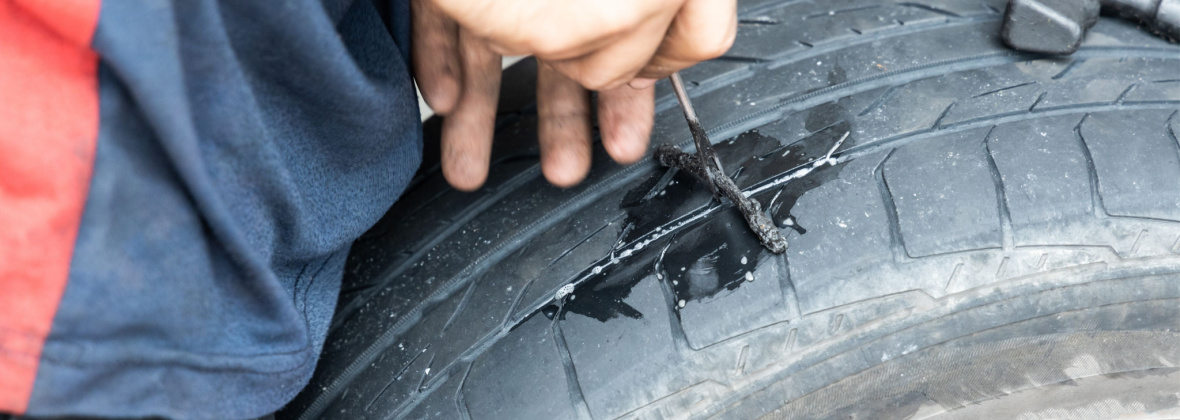Tire Repair Tips: Should You Plug or Patch A Tire?
October 20, 2022

If you’ve ever had a flat tire, you know the feeling of panic that sets in. Whether on the side of the road or in your driveway, all you can think about is getting your tire fixed as quickly as possible. But what’s the best way to fix a flat tire? Should you plug or patch it?
While both methods will get your tire back to functioning properly, there are some critical differences between the two. Tire plugs are typically used for smaller punctures, while patches are better for bigger holes. Plugging a tire is also generally a quicker and easier process than patching.
So, what’s the verdict? If you’re unsure which method to use, here’s a quick guide to help you make the best decision for your flat tire.
Introduction
At some point, every driver will experience a flat tire. Whether you hit a pothole or run over a nail, it’s essential to know how to properly repair your tire so you can get back on the road safely. But what’s the best way to fix a flat? Should you plug or patch your tire?
There are two main ways to repair a flat tire: plugs and patches. Both methods have their advantages and disadvantages, so it’s important to know what each option entails before deciding. Here’s a brief overview of each repair method:
Tire Plugs
Tire plugs are inserted into the hole in your tire to seal it and prevent air from escaping. Plugs are typically made of rubber or foam and are relatively easy to install yourself with the help of a plug kit.
One advantage of using tire plugs is that they’re less expensive than patches. They’re also quick and easy to install, which is ideal if you’re stranded on the side of the road with a flat tire. However, one downside of plugs is that they’re not as durable as patches and may not last as long. Additionally, some experts believe that plugs can actually cause more damage to your tires over time.
Tire Patches
Tire patches are applied to the outside of your tire and bonded with adhesive. Unlike plugs inserted into your tires, patches are used to cover holes in the outermost layer of your tire (the tread). Patches are generally considered more durable than plugs and they provide a longer-lasting repair. However, they can be more difficult to install yourself and they typically cost more than plugs.
If you have a choice between patching or plugging your tire, most experts recommend patching because it provides a stronger, longer-lasting repair. However, both methods can be effective ways to fix a flat tire if done properly. If you’re unsure about which option is best for your situation, it’s always best to consult with a professional before making a decision.
What is a tire plug?
A tire plug is a temporary fix for a punctured tire. It is a piece of rubber or other material that is inserted into the hole in the tire to seal it and prevent air from escaping.
What is a tire patch?
A tire patch is a small piece of rubber that is used to repair a hole or puncture in a tire. There are two types of tire patches: inner tube patches and tubeless patches. Inner tube patches are used on tires that have an inner tube, while tubeless patches are used on tires that do not have an inner tube.
How to plug a tire
If you have a flat tire, you may be wondering whether you should plug or patch it. Tire plugs and patches each have their own advantages and disadvantages, so it’s important to know what to consider before making a decision.
Let’s take a closer look at the benefits and drawbacks of each option so you can make the best decision for your situation.
Tire Plugs
Tire plugs are inserted into the hole in your tire to seal it and prevent air from escaping. Plugs are typically made of rubber or latex, and they’re relatively easy to install yourself.
One advantage of tire plugs is that they’re typically less expensive than patches. They’re also quick and easy to install, which can be important if you’re stranded on the side of the road with a flat tire.
However, there are some drawbacks to tire plugs as well. One is that they don’t always provide a permanent fix; the plug could come out over time, which would leave you with another flat tire. Additionally, air can still leak around the edges of the plug, so it may not hold pressure as well as a patch. And finally, some tire experts believe that plugs can actually weaken the sidewall of your tire, making it more susceptible to future flats.
Patching Your Tire Patching your tire involves bonding a patch over the hole in your tire to create a new airtight surface. Patches are usually made from vulcanized rubber, which means they can provide a very strong and permanent repair.
One advantage of patches is that they’re very sturdy and long-lasting; once a patch is installed, it shouldn’t come off or allow air to escape. Additionally, because patch bonding material actually permeates into tiny crevices in the sidewall of your tire, it can provide an even stronger repair than a plug.
There are some disadvantages to patching as well, though. One is that it’s typically more expensive than installing a plug; you’ll need to pay for both the patch itself and for labour if you have someone else do it for you. Additionally, because patches require removal of the tire from the rim (to allow access for bonding material), they usually take longer to install than plugs do
How to patch a tire
There are two ways to fix a flat tire: You can either plug it or patch it. Both methods are fairly easy to do, but they each have their own set of pros and cons.
Tire plugs are typically made of rubber or latex and are inserted into the tire to fill the hole. Tire plugs are a quick and easy fix, and they can be done without even taking the tire off of the car. However, tire plugs are not a permanent fix, and they may not be as effective in sealing larger holes.
Tire patches, on the other hand, require you to take the tire off of the car so that the hole can be patched from the inside. Tire patches are a more permanent solution, but they do require more time and effort to complete.
Tire plug vs tire patch
There are two different ways to fix a flat tire: with a tire plug or a tire patch. But which one is the better option?
Tire plugs are inserted into the hole in the tire to seal it up. They’re quick and easy to do, and they’re a temporary fix. Tire patches, on the other hand, are glued onto the hole in the tire. They take longer to do, but they’re a more permanent solution.
So, which one should you choose? If you have a small hole in your tire, a tire plug will probably be just fine. But if you have a large hole or if your tire is severely damaged, you’ll need a tire patch.
Tire services
Tire services can be performed at a wide variety of businesses, from car dealers to local gas stations. However, not every business offers the same quality or range of services. When it comes to something as important as your tires, it’s important to choose a reputable company that can offer the services you need.
There are two basic types of tire repair: plugs and patches. Both have their benefits and drawbacks, and the best choice for you will depend on the severity of the damage and your personal preferences.
Tire plugs are typically used for small punctures in the tread of the tire. They are inserted into the hole and then inflated, expanding to fill the hole and seal it off. Plugs are a quick and easy way to repair a flat tire, but they are not considered permanent fixes. They may also come out over time, especially if they are not installed correctly.
Tire patches are similar to plugs, but they involve bonding a patch over the hole in the tire. This patch is then inflated along with the rest of the tire. Patches provide a more permanent solution than plugs, but they can be more difficult to install correctly.
Tire repair near me
It’s happened to all of us. You’re driving along and suddenly you hear that telltale thump, thump, thump. You pull over to the side of the road and discover you have a flat tire. Now what? For years, motorists have been debating whether it’s better to patch or plug a tire when they get a flat. The truth is, there is no definitive answer. It depends on the kind of tire damage you have and the condition of your tires. Here’s a look at the pros and cons of each method to help you decide what’s best for you.
Patching a Tire
Patching a tire is generally considered to be the most reliable repair method because it offers a permanent fix. A professional technician will remove the wheel from your car, take out the damaged inner liner, clean the area around the hole, and apply a vulcanizing patch over the hole. The patch is then covered with cement before being inflated and checked for leaks.
Pros: Patching is a permanent repair that will strengthen the tire and prevent air from leaking.
Cons: Patching can be more expensive than other repair methods because it requires special equipment and training. In addition, some tire experts believe that patching may shorten the overall life of your tires because it can make them more susceptible to heat build-up. If not done correctly, patching can also cause further damage to your tires.
Plugging a Tire
Plugging a tire is generally considered a temporary repair method that should only be used in emergencies. To plug a tire, a professional technician will insert a special rubber plug into the hole in your tire, and the plug is then inflated and checked for leaks.
Pros: Plugging is less expensive than other repair methods and can usually be done quickly and easily by anyone with basic automotive knowledge.
Cons: Because it’s only a temporary fix, plugs can come out of your tires over time, causing air to leak out again. In addition, some experts believe that plugs can cause further damage to your tires because they leave holes in the tread that can collect water and snow, which can lead to sidewall or tread separations over time.
Back

